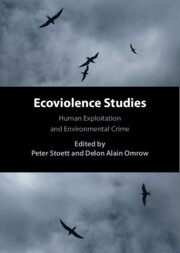Book contents
- Ecoviolence Studies
- Ecoviolence Studies
- Copyright page
- Contents
- Contributors
- Foreword
- Foreword
- Preface and Acknowledgments
- 1 Ecoviolence Studies and Human Security
- 2 The Links between Human Trafficking and Wildlife Trafficking
- 3 Preventing a Secondary Disaster: How Emergency Management Agencies Can Prepare and Respond to Disaster-Linked Exploitation
- 4 Ecoviolence at Sea
- 5 There Will Be Blood: The Return of the Frontier Logic in Guyana and Hyper-Exploitation in the Mining Sector
- 6 Artisanal Gold Mining in Uganda: Towards Formalization as Remediation of Dignity and Rights
- 7 Searching for Shelter in the Climate Crisis Era: Ecocide and Migration
- 8 Climate Change, Violence and Ecocide
- 9 Sea of Cortez Region: Crime and Ecosystem Crossroads
- 10 Minority Languages as Collateral Damage in the Climate Crisis: The Incidental Result of Ecoviolence on Y Gymraeg/Welsh Language
- Index
- References
9 - Sea of Cortez Region: Crime and Ecosystem Crossroads
Published online by Cambridge University Press: 13 February 2025
- Ecoviolence Studies
- Ecoviolence Studies
- Copyright page
- Contents
- Contributors
- Foreword
- Foreword
- Preface and Acknowledgments
- 1 Ecoviolence Studies and Human Security
- 2 The Links between Human Trafficking and Wildlife Trafficking
- 3 Preventing a Secondary Disaster: How Emergency Management Agencies Can Prepare and Respond to Disaster-Linked Exploitation
- 4 Ecoviolence at Sea
- 5 There Will Be Blood: The Return of the Frontier Logic in Guyana and Hyper-Exploitation in the Mining Sector
- 6 Artisanal Gold Mining in Uganda: Towards Formalization as Remediation of Dignity and Rights
- 7 Searching for Shelter in the Climate Crisis Era: Ecocide and Migration
- 8 Climate Change, Violence and Ecocide
- 9 Sea of Cortez Region: Crime and Ecosystem Crossroads
- 10 Minority Languages as Collateral Damage in the Climate Crisis: The Incidental Result of Ecoviolence on Y Gymraeg/Welsh Language
- Index
- References
Summary
This chapter explores ecoviolence along the Sea of Cortez, and Mexican cartels’ decades-long monopoly of the illegal drug market. Through this illicit economy, we unpack the convergence of illegal waste dumping, the illegal wildlife trade, money laundering, and human smuggling, and the role that Mexican, Chinese, and Fujian criminal organizations play in regional, interregional, and transnational exchanges to further criminal activities. The Sea of Cortez is a fascinating case study due to its geographic location as a historical hub for smuggling multiple commodities such as totoaba bladders, shark fins, drugs, diamonds, and precious metals. But the smuggling of immigrants has now come under the purview of these criminal networks. The chapter concludes with proposing a new analytical framework for studying ecoviolence, building expert capacity for undertaking research and analysis of policy development and enforcement.
Keywords
- Type
- Chapter
- Information
- Ecoviolence StudiesHuman Exploitation and Environmental Crime, pp. 158 - 169Publisher: Cambridge University PressPrint publication year: 2025

